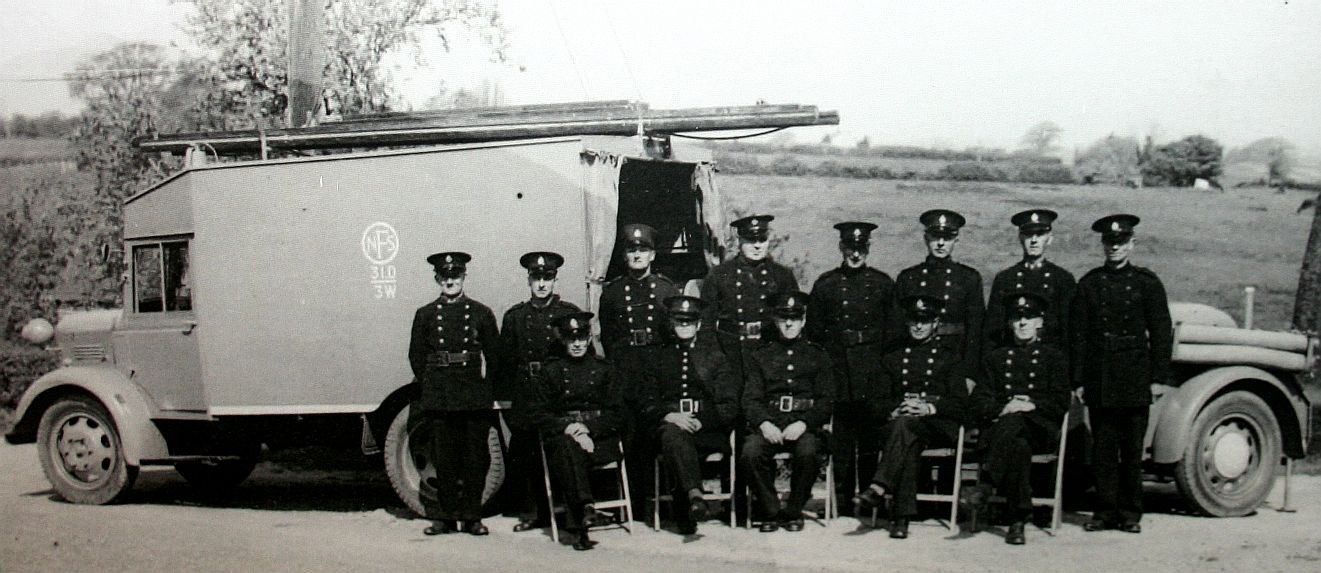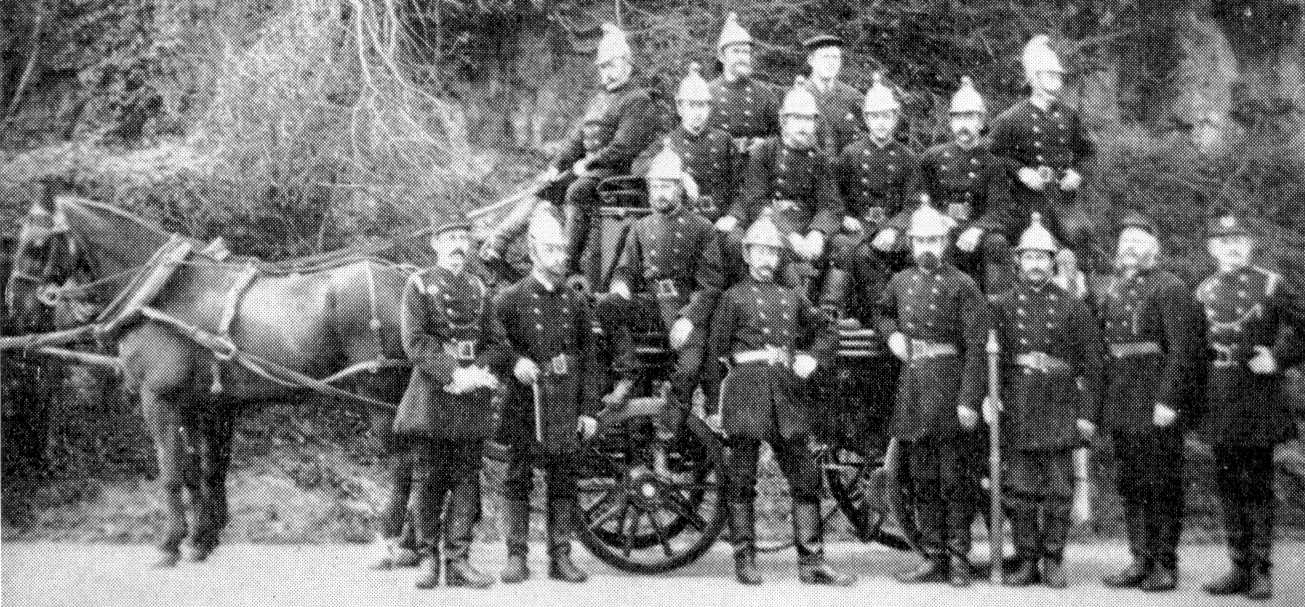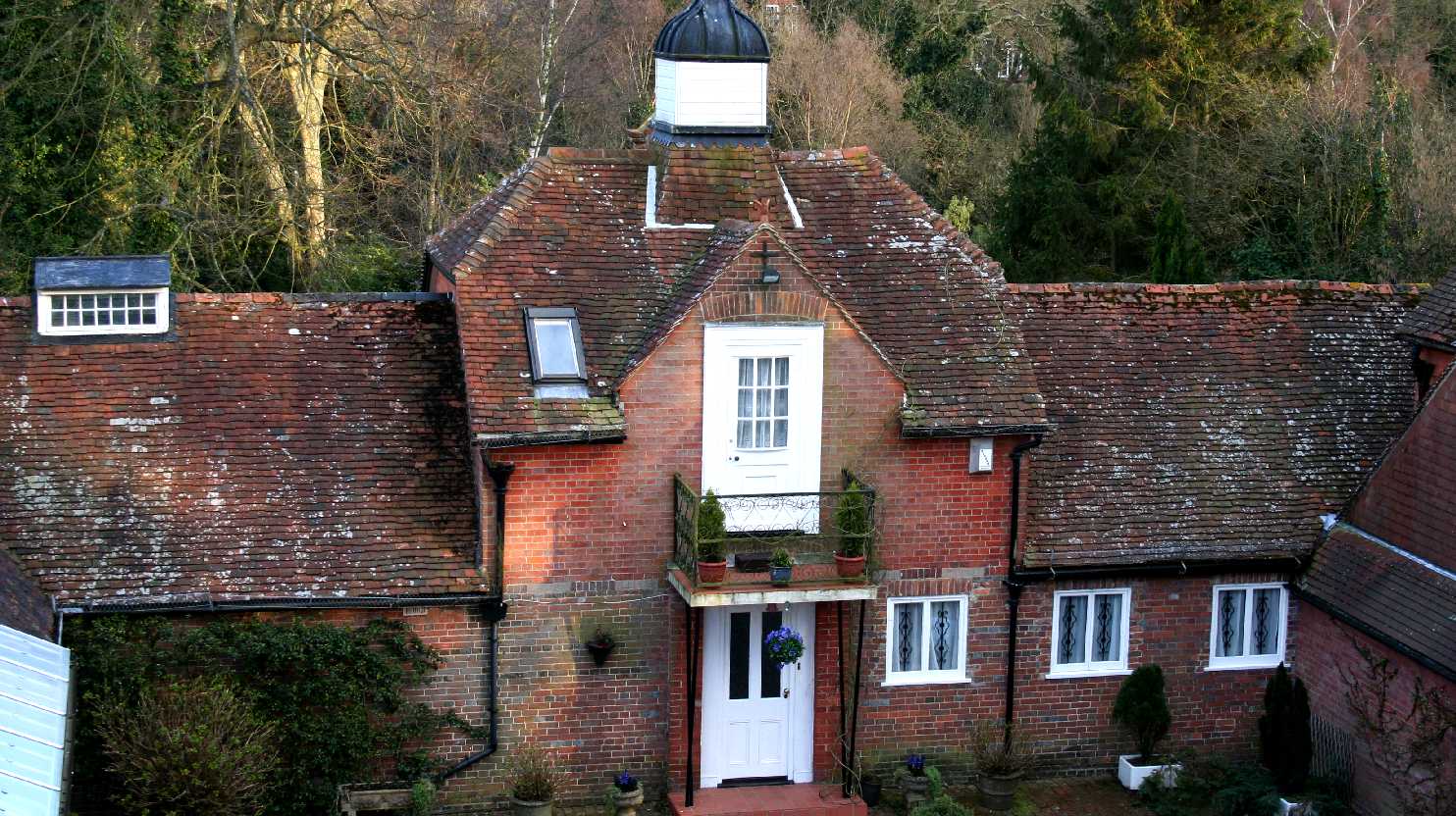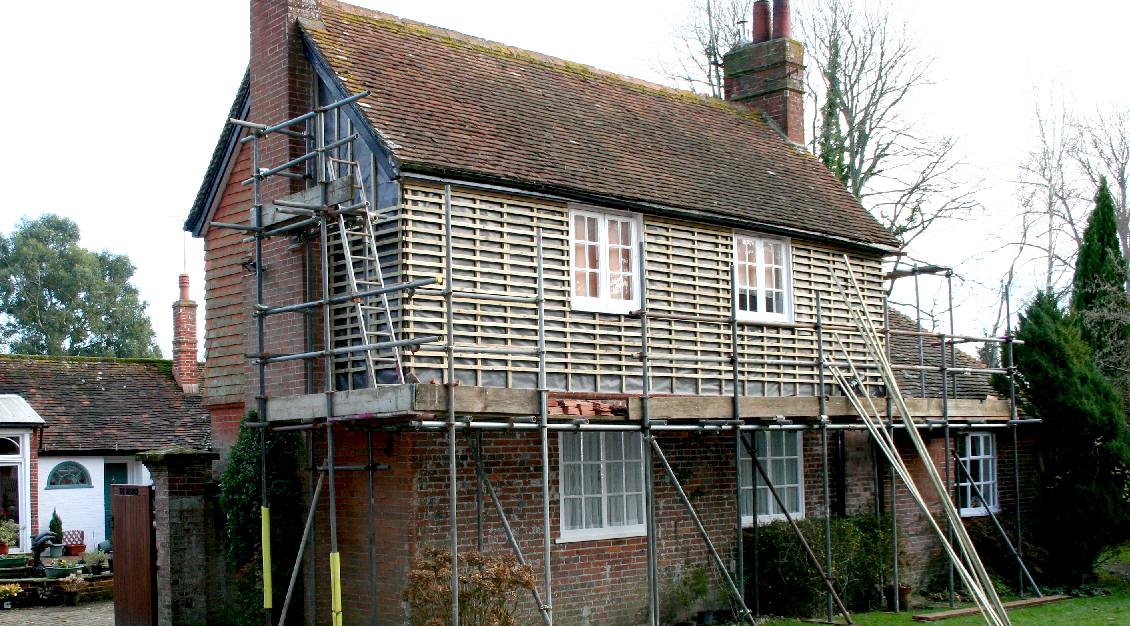|

FIRE
- We all love to sit in front of a fire, whether at home, at a campsite
or bonfire. Fires keep us warm on cold winter nights - these days more
controlled in a central heating system - but combustion just the same.
The oxygen (O2) in air (21%) is necessary for combustion. Whatever the amount of fuel available (wood, paper, cloth), combustion will stop when the air becomes "thin", i.e., when it contains less than 15% oxygen. Damping a fire is typically done by spraying water onto the flames, where evaporation absorbs heat and puts water vapour into the atmosphere, so reducing the oxygen content.

NATIONAL
FIRE SERVICE - Herstmonceux had its own fire service and station in
1943. Here the regulars are out on the road with the familiar background
of Church Road or Chapel Row.
Prior to the Great Fire of
London in 1666, some parishes in the UK had begun to organize rudimentary
firefighting teams. After the Great Fire, Nicholas Barbon introduced the first fire insurance. In order to reduce insurance costs, Barbon also formed his own fire brigade, and other companies followed suit.

By the start of the 1800s, insured buildings were identified with a badge or mark, indicating that they were eligible for firefighting services. (Buildings with no coverage, or insurance with a different company, were left to burn, unless they happened to be adjacent to an insured building, in which case it was often in the insurance company's interest to prevent the fire from spreading.) In 1833, these companies in London merged to form The London Fire Company Establishment.
Steam powered apparatuses were first introduced in the 1850s, allowing a greater quantity of
water to be directed onto a fire, and in the early 1930s, they were superseded by versions powered by an internal combustion engine.
In World War
II, the Auxiliary Fire Service and later the National Fire Service were established to supplement local fire services. At that time, there was no countrywide standard for firefighting terms, procedures, ranks, or equipment (such as hose couplings). These were standardized after World War II.

DRILL
HALL
- These were the old stables in Lime Park, now converted to a bedroom in a
residential unit with an internal staircase to replace the original
external ironwork. The building was used by the Herstmonceux Fire
Service in days gone by to practice their drills. This was during the
period when horses were no longer needed, making the stables redundant
and so an obvious location to take advantage of.
If you have any interesting stories to
tell about the old village fire service we would be pleased to hear from
you.
CONTACT
US
The
Curator
Lime
Park Heritage Trust
Herstmonceux
Museum
Lime
Park
Herstmonceux
East
Sussex
BN27 1RF,
UK
Telephone:
0044 1323 831727

OLD
RECTORY - A part of the stable complex undergoing repairs in 2014.
The original clay tiles were replace with more modern cement hung tiles
because the clay tiles were too badly eroded to be re-hung. This was a
great shame and another heritage loss in Lime Park.
In
2016 the owners of this building applied for planning permission to
convert the garages and another tin covered building to increase the
area for the retired couple. The proposed works included excavations
that fell to be considered under the Party Wall Act and presented a
potential risk of subsidence to the adjacent Herstmonceux Museum. In
addition, from the loss of the garages logic dictated an increase in
parking in the shared drive. None of these issues were addressed in the
application by Peter Townley and there were other declaratory issues
that needed to be corrected. The Lime Park Heritage Trust (LPHT) were
forced to raise these matters by way of formal objection, without
objecting in principle to the proposal that the present owners might
enjoy permitted development rights during their retirement. The planning
application was passed, subject to suitable conditions that, if adhered
to, will give the LPHT an opportunity to review the proposals. In
addition, where parking is an issue from time to time, the local Fire
Service will be called to look at the access issues as per the East
Sussex Act.
F.A.O. Laura Field FAX & POST 01892 602777
Planning & Environmental Services
Wealden District Council
Vicarage Lane
Hailsham
BN27 2AX
27 August 2016
Dear Ms Field,
Re: APPLICATION No. WD/2016/0809/F
The Old Rectory, Lime Park, Herstmonceux, East Sussex
Thank you for your letter dated 25-8-16.
We write further to our associate trustees letter dated the 22nd of August 2016, and to give your area plans south committee additional examples of the congestion in Lime Park.
The inevitable rental expansion, stemming from the lack of affordable housing in Sussex, is likely to place additional parking pressure locally and more so if the owners of numbers 1 and 2 Lime Park ever decide to join the ranks of the landlord brigade now permeating the south-east of England.
For the sake of continuity, and as we are also supplying a number of photographs in support of our Trusts formal objection(s) to the conversion and extension of The Old Rectory, we have adopted a similar index format to that used by the Cleaner Oceans Club Ltd., with 22 more pictures that we hope are adequate for the present purposes.
We felt that the case for refusal of the present proposal had been made out sufficiently by our associates, but that was until the morning of the 24th of August (Wednesday) when a truck came as usual to collect the waste stored in bins, except that on this occasion the vehicle was unable to gain access to the upper drive (where the Rectory is located) by driving around the Park clockwise (or indeed anticlockwise), because a four wheel drive vehicle was parked near the north-west corner of the Park preventing any large vehicle from negotiating that turn as per the normal route. Please see photograph numbers 1, 2 and 13, where photograph 13 was taken on Saturday the 27th of August.
The driver of the Mercedes vehicle was forced to reverse his truck all the way back to the fork near 1 Lime Park (Lime Cottage - Mrs Lambert), a very time consuming process, then drive forward up the slope to the Rectory and the other bins, where number 2 Lime Park (Linden House - Mr & Mrs Gallagher) store domestic waste in the drive in bins near their garage at the top of Lime Park.
As you can see from the photographs supplied, the driver of the Mercedes dustcart was forced to do the only reasonable thing he could and leave a note on the windscreen on the 4x4 vehicle, to ask the owner not to park in that location. You can also see the truck reversing back down the drive in photograph number 1 and of course the extremely tolerant driver then had to reverse all the way back along Lime Park south, to the entrance to Lime Park, in Church Road, before he could continue with his rounds. This meant reversing into Church Road blind, rather than driving out of Lime Park with full cab visibility, going forward.
You enter Lime Park from Church Road, via a narrow lane that has a tarmac surface until after a couple of hundred yards the tarmac lane joins with a square that is gravel surfaced and forks east and north. There is no prescribed direction of travel around this square, with drivers circling the central gardens that are divided into three strips (without boundaries) belonging to 1, 2, and 3 Lime Park. The east quarter of the drive is owned by number 4 Lime Park (Mrs Askaroff). Each owner/occupier has a right of way for their vehicles and for service vehicles. A right of way should be maintained at all times, with nobody parking in the shared drive in such a manner as to obstruct access. But this is not always possible concerning large service vehicles, due to the intensification of vehicle use and ownership in the park and an increase in service vehicles.
For example, Where Mrs Askaroff rents the property in the corner of the Park (see photograph 22) there are three vehicles associated with this relatively recent occupation. The same applies to number 2 Lime Park, where there are four vehicles associated with this occupation. Previously, Louise Jones only used one car and rented her garage to a motorcyclist for storing his bike. Number 3 Lime Park is rented out by the present (ex pat) owner/landlord, Hugh Andrews, where the number of vehicles varies with each tenant. When owned by Camille de Kok, she parked just one car. The property attracting the most service vehicles within the Park is The Old Rectory and this is because of the assistance needed most recently in connection with advancing years.
Two days after the refuse truck incident, on the 26th of August a gardener parked in exactly the same location in the drive as the 4x4 vehicle on the 24th. Please note that other drivers visiting residents in Lime Park also park in the same location and that this is not an isolated practice by this 4x4 driver but is common practice. Presumably, all of these drivers are unaware of the requirements for unimpeded access as per the requirements of the East Sussex Act of 1981. Alternatively, those parking near to this corner believe that their car will not cause an obstruction, where clearly, we now have a documented incident to prove otherwise.
THE EAST SUSSEX ACT 1981 S. 35
The situation described above would, in our opinion, be of obvious concern to the Fire Brigade, since it is a legal requirement to keep access clear at all times for fire engines. Such a situation as witnessed on the 24th and again on the 26th and 27th would undoubtedly have caused a problem if the emergency services needed urgent access to the residential unit in that top left hand corner of the Park (north-west), since there is a property that is occupied residentially in that location and access for fire hoses and the like would have been prevented.
In looking at the situation in the north-west corner of the Park, we must consider that situation in context with the approach from the other direction. If a fire engine could not get through or past the as yet unidentified (unnamed) residential unit in the north-east corner of the Park (photo 22) and so could not use this route to get a fire truck to The Old Rectory, or Herstmonceux Museum, that becomes a major problem if the access is also impeded via the alternative route using the east fork of the drive. Please refer to photograph one and then compare this picture with photographs 6, 7, 8 and 20.
In photograph 20, a car has parked on the left of the drive outside the Old Rectory (looking down the drive) opposite a VW golf, where the same VW is seen in picture one on the right of the drive. If the car on the left in picture 20 had been parked there on the 24th of August, then the Mercedes truck, or a fire engine, would not have been able to gain access to The Rectory or Herstmonceux Museum in contravention of the clear requirements of the East Sussex Act 1981 - requiring access at all times. Parking outside of the Rectory in this location is, unfortunately, frequent.
A back route to Lime Park from Gardner Street is presently blocked with logs. See photograph 21. But is in any event not a practical route where the farmer locks his gate near the cricket grounds and so would need to be roused from his distant farm to open up for a fire engine. Lime Park Estate Limited also lock a gate just the other side of the logs.
At Section 35 the 1981 Act states:
Except as provided in subsection (2) below, where plans for the erection or extension of a building are deposited with a district council in according with building regulations, the district council shall reject the plans unless, after consultation with the fire authority, they are satisfied that the plans show: -
(a) That there will be adequate means of access for the fire brigade to the building or, as the case may be, to the building as extended; and
(b) That the building or, as the case may be, the extension of the building, will not render inadequate any existing means of access for the fire brigade to a neighbouring building.
As our associate Trustee (Cleaner Oceans Club Ltd) pointed our in their recent letter, the loss of two garages for parking in Lime Park is likely to have an impact on the access to large vehicles in due course, though this may not be immediately obvious, so needs to be explained with the benefit of the photographs supplied that show the parking trends that a single site visit would be sure to miss.
Section 35 (b) of the East Sussex Act is clear, that in the case of any extension of a building that may render inadequate any means of access for the fire brigade to any neighbouring building, that the district council shall reject the plans unless they consult with the fire authority and the fire authority is persuaded that there will be adequate access in the future.
We would respectfully suggest that the present proposal, being the extension of residential use of The Old Rectory to displace two garages, is likely to render inadequate the existing means of access to a neighbouring building, that building being Herstmonceux Museum.
We would also respectfully suggest that the applicant has not sufficiently addressed this issue and not provided information of parking trends as our Trustees are attempting to do. We aver that the displacement of two garages in Lime Park needs to be addressed by the applicant, where the parking situation is considerably different from when the last application for such proposal was passed in 2007.
Collectively, we think that we have now provided proofs as to what the parking situation is today, where such proofs give weight to the proposition that parking is already extremely difficult such as to conflict with the East Sussex Act - and that any additional load that is created by the loss of two existing garages is sure to create difficulties for large service vehicles in the future by way of increased parking overspill. This overspill in turn can only make matters worse, demanding proposals from the applicant to overcome this statutory obstacle to grant.
We stress that this is for the applicant to address, not Lime Park Estate Limited. The applicant is not Lime Park Estate Limited. Lime Park Estate Limited is an occupiers company that exists to service the shared drive, where the drive was transferred from Wickens Estates to a local company for that express purpose, based on the previous pattern of use and any pre-existing easements or rights of way.
At the present time, The Old Rectory is a self-contained unit in parking terms, though the owners are keen on throwing open days as evidenced by photograph numbers 11 and 12, this is usually only for a couple of days a year for which planning permission is not required. In essence though, the two garages that the owners presently enjoy, are considered to be an essential feature in a location where parking problems appear to ourselves and our fellow trustees to be on the increase and a feature that future owners will come to value all the more, should other owners in the Park exercise their right to use the shared driveway for parking overflow.
We are not alone in this regard. Individual Directors of Lime Park Estate Limited, and this company as a company, have made mention of it in correspondence with another occupier who reports and records such matters for our Trust. Unfortunately, this correspondence is privileged at the moment, meaning that we cannot use it unless this matter goes to appeal.
The planning committee may like to know that Herstmonceux Museum also has two garages for vehicle parking and storage, but that because of visitors, site workers and the like, the clutter in the Park is such that we often feel it necessary to park a vehicle in Church Road to enable access for delivery drivers. It is possible that we are the only occupiers in Lime Park to do this and we do this because we appreciate that access is needed at all times for emergency and other service vehicles.
Where we are a Museum, we aim to curtail visitor numbers by only allowing third parties access to the generating buildings and exhibits by appointment and very infrequently far less frequently than the 28 days that are allowed for events without planning consent unless the Park were to radically change ownership and/or conservation status when parking could be incorporated in a more organised fashion. This though is unlikely to come about in the foreseeable future, but is more of a longer-term conservation hope.
NOISE & DISTURBANCE
Where there is at present one family unit occupying the former stables, there will in effect be two families occupying the unit, with one unit requiring qualified professional nursing and home help and the other most likely having children or other friends visiting, but even if this is not the case, there will be additional traffic and other service movements that will increase the noise and disturbance from the additional comings and goings that is likely to be associated with the expanded residential use of the premises.
The applicant has milk and newspapers delivered by motor vehicle, aside from the home help and ambulances that appear from time to time. The applicant also has oil delivered by a large truck from time to time as evidenced by photograph number 5.
GARDENERS & HOME HELP
The directors of Lime Park Estate Limited employ a veritable army of gardeners (mostly Perfect Gardens) to keep their gardens in good order all of which generates regular vehicle movements, typically two vans and other vehicles, when some of the ground workers use their own vehicles.
The applicant is known to have employed at least two other gardeners regularly. One drives a silver 4x4 as seen in photograph number 6, the other drives a dark blue 4x4 as seen in photograph number 18. The reason for so many ground workers is because the two main features of The Old Rectory are (a) the garden and (b) the pond and these features take a lot of tending to keep the gardens in show condition for summer parties, as per photograph 12.
In earlier years Mr Townley would cut the grass using his ride on mower, he no longer tends his extensive lawn himself.
WATER FEATURE
In the middle of their courtyard, we understand that the applicant installed a water feature that is of course attractive, but also limits parking movements inside the yard, the water feature acting as a roundabout inside the courtyard. You can see a photograph of this at page 13 of the exhibits. This is another reason that the garages are so important, where it only takes one car in the courtyard to cause a blockage at the entrance and so to traffic flow, that prevent easy movements and encourages visitors to park just outside the Rectory, so potentially blocking the drive for fire engines. Whereas, using the garages, it is possible to keep the yard clear for emergency vehicles, such as those of the fire brigade and ambulances that may otherwise not be able to reach the far corners of the building complex. There is no other access to the Rectory for fire engines, save from the shared drive.
This point is made in addition to the existing vehicle blockage issue in the shared drive.
The garages are therefore an important safety feature in fire terms, rather than simply a convenience for the owners.
LEYLAND CYPRUS
There is a row of these fast growing evergreen trees along a boundary in a north-easterly direction the trunk of one that is literally only four feet from the foundations and an archaeologically important water filter at one point (a valuable part of the generating complex).
Set too close to a building - closer than 15 to 20 feet to a house for example - and the crown of a leylandii suffers from poor air circulation at maturity. Cypress roots grow past the tree's drip-lines and against the foundation. There are only two options for roots in this predicament:
1. Stop growing, or
2. Burrow or into the foundation.
Option one produces a top-heavy tree with a weak root system that could easily tip over in wet weather. The second option leads to foundation damage.
Any one of these two scenarios is unsatisfactory and therefore presents a danger to the historic generating buildings and the proposed conversion to the potting shed.
Typically leylandii require a lot of work to keep tidy (around 40 hours a year) and should be trimmed at least once a year at the very least because they can grow up to 4 feet (1.2m) each season in early years, reducing to 18-36 inches in later life - according to reliable sources.
The applicant(s) have not tended these trees in over three years and in view of their advancing years and history of not adequately dealing with this row of trees, enforcement action is likely, where the spacing and proximity of a tree that grows to a diameter of 15-20 feet is considered to be intrusive, so placing a burden on our trustees that is both untenable and unreasonable. Please see photograph 16 as an extreme example of how leylandii can get out of hand where an owner fails to spend time keeping them under control.
When this row of trees were planted, this appears not to have been taken into consideration by the then owners who replaced a line of iron post and rail fencing that constituted the boundary in 1983.
Where the previous owners may legitimately have claimed ignorance of the archaeological value of the extant foundations and features, the unsuitability of the planting cannot have escaped the attention of the present owners, who appear to encourage the nuisance and/or harm that these trees are causing to the generating building foundations, with overhanging and the deliberate deprivation of light.
You can see at photograph 14 that the present owners of the Rectory have engaged tree surgeons to deal with other potentially dangerous trees in this location, but not the leylandii.
We understand that this is termed antisocial behaviour and that enforcement action is often the only way to bring such delinquency to an end. From the photographic evidence that we have seen, we would have to agree that this is an actionable nuisance that may well end up as a claim against the property owners in the event that litigation becomes unavoidable and/or a claim against the successors in title or trustee(s) of the applicant(s) estate.
Leylandii are liable to get uprooted in storms even if they are tens of years old in certain conditions, making them dangerous to plant near buildings. They also consume a lot of water, so may be the cause of subsidence issues in hot summers where clay soil is involved as is the case here and that damage insurance companies are unlikely to pay for, so voiding any policy and rendering the owners of the trees uninsured, hence personally liable for what amounts to negligent husbandry or as may or may not be the case, arboreal thuggery. Insurance companies are unlikely to settle claims against an owner in the case of irresponsible planting and failure to properly tend, such as in this instance.
Having demonstrated that these owners are less than likely to take what is considered to be the usual precautions concerning this particular boundary, the conversion of the potting shed ought not to be allowed without a condition that the nearby leylandii be removed (or otherwise suitably treated) prior to the start of any building works. We understand that conditional planning consent is dealt with by way of a 106 Agreement.
May we also respectfully offer that Historic England might be consulted in relation to the likely root damage that the extant leylandii pose to the archaeological remains and that the Fire Brigade might be consulted as to the East Sussex Act 1981 and the perceived parking difficulties.
If we can offer any further clarification or can help your council to gain a fuller appreciation of the difficulties that the present proposal represents, please do not hesitate to contact us.
Yours faithfully,
Solar Cola Ltd (Trustee)
for Lime Park Heritage Trust
LINKS
Tyrrell
Sussex books
Maureens
Choice A_Sussex_Sunset
https://en.wikipedia.org/wiki/Farman_MF.7
http://www.eastbournehistory.org.uk/timeline.php
http://www.thepeerage.com/p1827.htm
http://www.raf.mod.uk/
http://www.tyrrellsussexbooks.com/books_3.php
http://www.maureenschoice.co.uk/book_windows/a_sussex_sunset.html
HERITAGE
INDEX A - Z
AIR
RAID SHELTER
AVIATION
- EASTBOURNE
BARCLAYS
BANKING LET DOWN - MISSING ACCOUNT MONEY
BARON
CARL VON ROEMER & CHARLES de ROEMER
CAMPBELL
HALL - BLUEBIRD ELECTRIC CARS
COAL
BUNKER
GAS
ENGINES - COAL CONVERSION, INTERNAL COMBUSTION
HX
FIRE STATION
HX
MUSEUM
HX
SCIENCE EXHIBITS
OBSERVATORY
- HERSTMONCEUX CASTLE
SX
MUSEUMS
PLANNING
APP JAN 2015
RAF
BEACHY HEAD
RAF
HERSTMONCEUX
RAF
HERSTMONCEUX & WARTLING
RAF
SEAFORD BAY
SOLAR
LADY - STATUE
SUMMER
SOLSTICE
SUSSEX
TRUGGERY
THOMAS
ALVA EDISON
TOURISM
DCMS
TREE
HOUSES -
TREE
PRESERVATION
TRUGS
WORLD
ELECTRIFICATION HISTORY
WWII
BOMB PROOF SHELTER
|




